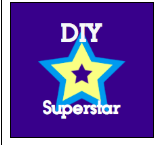 National STEAM day is celebrated on November 8, but you can create STEAM all year long! Check out this rocket launcher experiment that you can do to celebrate the national day dedicated to Science, Technology, Engineering, Art, and Math.
National STEAM day is celebrated on November 8, but you can create STEAM all year long! Check out this rocket launcher experiment that you can do to celebrate the national day dedicated to Science, Technology, Engineering, Art, and Math.
Spark your thinking!
1. Set up your STEAM mini spark recording page: #28: Rocket Launcher
2. Watch this video. Write down the materials you will need on your recording page
3. Collect the materials you need. Contact the EY coordinator in your building via email if you need help with this step. Add a picture of of your supplies to your recording page.
4. Go back to step 2 and rewatch this video while you are working.
4. Take pictures from your experiment and add them to your recording page.
5. Take a video of your rocket launcher.
6. On your recording page, create a one paragraph summary about your project.
7. Share your STEAM mini spark recording page and your video with your teacher/EY coordinator.
Check out the DIY superstar badge on the EY website

Post adapted from https://projectmc2.mgae.com/#/experiments



 Know what you want to write but aren’t sure where to start? These sentence prompts will help. Remember these 6 openings and you can write anything you want
Know what you want to write but aren’t sure where to start? These sentence prompts will help. Remember these 6 openings and you can write anything you want Many years ago, it was common for students to regularly be assigned the memorization of a poem or part of a historical document. Today, that does not happen in schools as regularly. But, did you know that memorization is good for you???
Many years ago, it was common for students to regularly be assigned the memorization of a poem or part of a historical document. Today, that does not happen in schools as regularly. But, did you know that memorization is good for you??? Multiplication. It is one of the four types of operations you learned in math (along with addition subtraction and division). There are many different ways to multiply numbers. However, sometimes, multiplying really big numbers can be a challenge. Luckily, there are many different techniques you can use to solve large multiplication problems.
Multiplication. It is one of the four types of operations you learned in math (along with addition subtraction and division). There are many different ways to multiply numbers. However, sometimes, multiplying really big numbers can be a challenge. Luckily, there are many different techniques you can use to solve large multiplication problems. Numberphile is a YouTube channel that posts many videos about many different math concepts. The channel has numerous videos on many real life examples. It is a great channel to learn about concepts not necessarily taught in school. One video that the channel contains is about a super egg, or a superellipse.
Numberphile is a YouTube channel that posts many videos about many different math concepts. The channel has numerous videos on many real life examples. It is a great channel to learn about concepts not necessarily taught in school. One video that the channel contains is about a super egg, or a superellipse.

